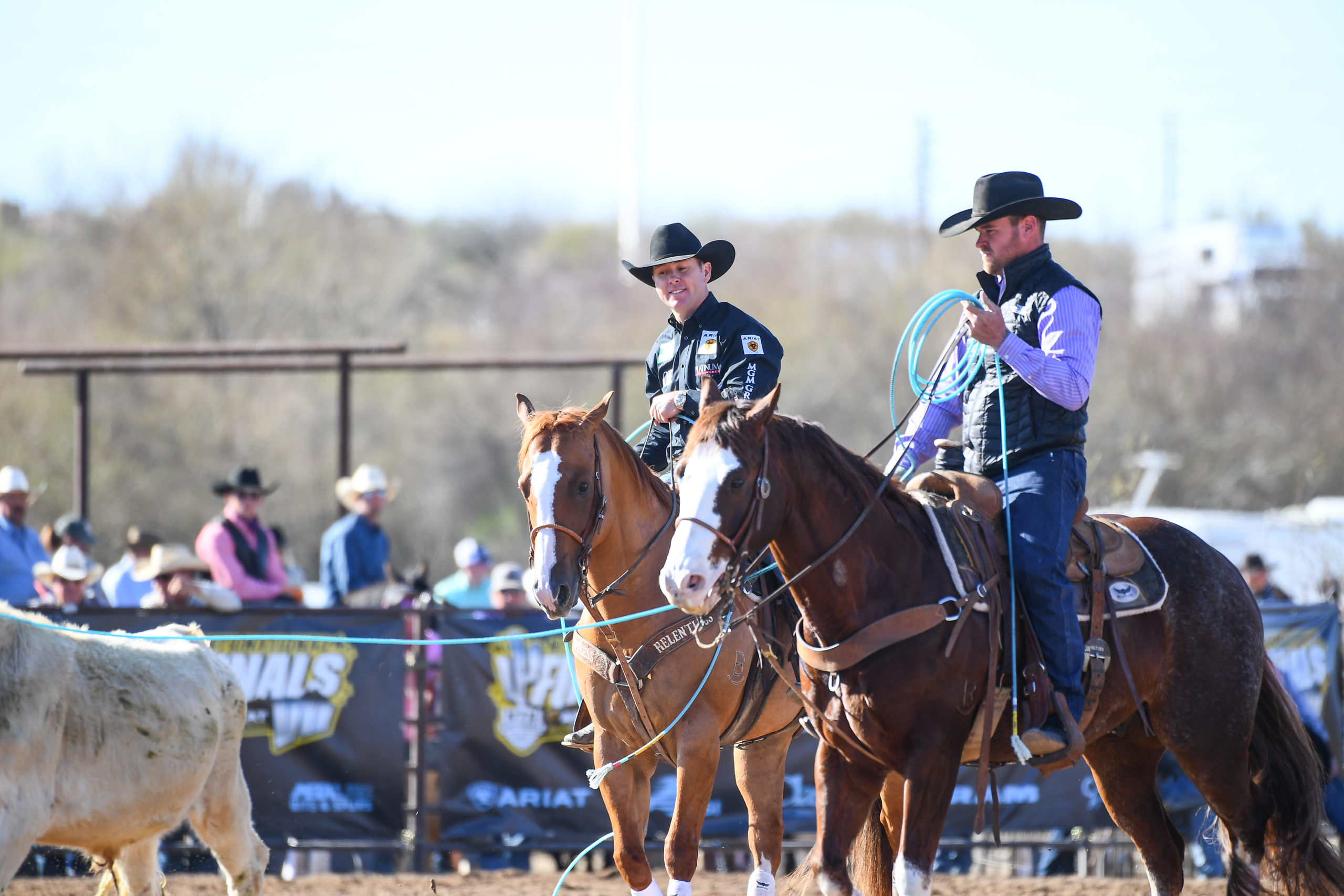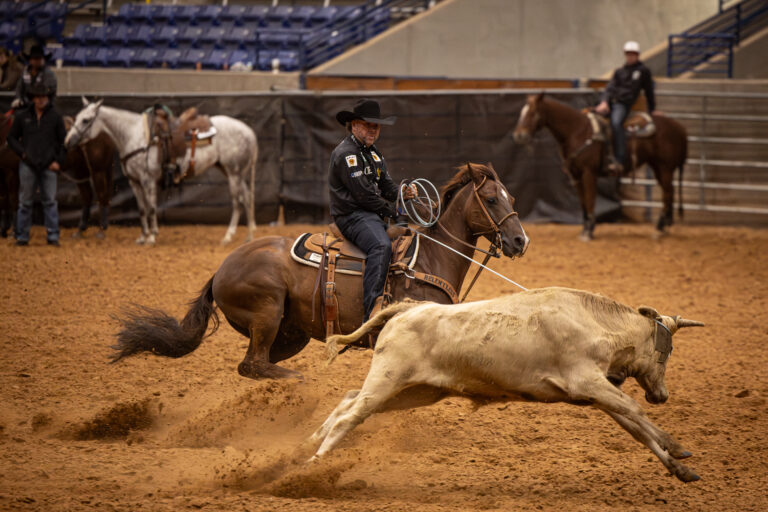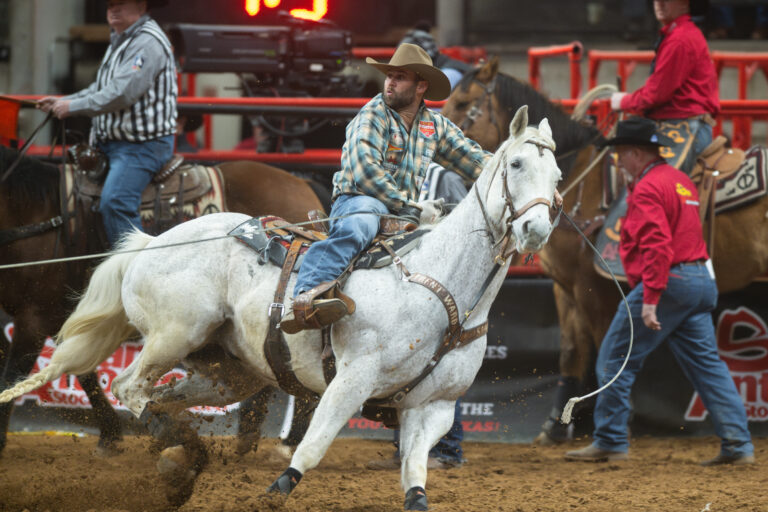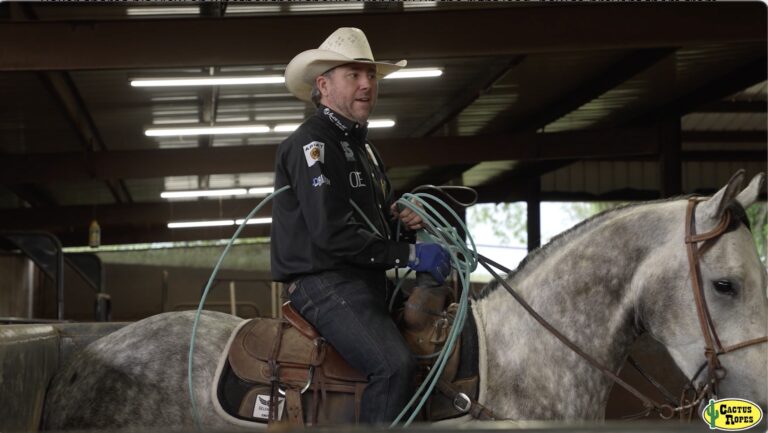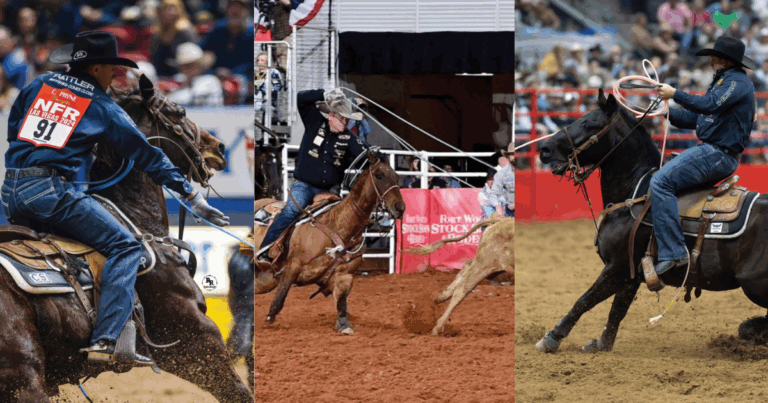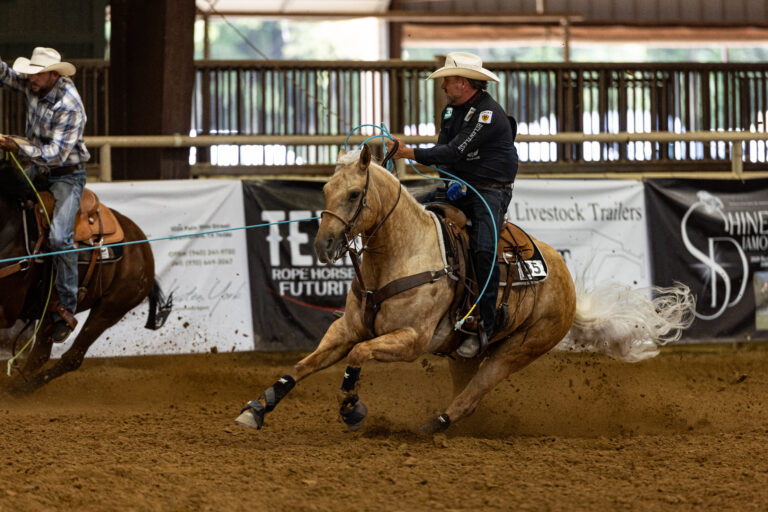Miles Baker was Trevor Brazile’s partner on the head horse, Smartys Dunny, that just sold for $250,000 last weekend at the Horse Sale at Rancho Rio, and he’s partners with Brazile on many of the top-tier horses you’ve seen the King of the Cowboys on everywhere from the BFI to the American Rope Horse Futurity Association’s World Championship.
He’s part of the secret sauce for Trevor Brazile, Joseph Harrison and Lari Dee Guy when it comes to making great horses.
We tapped him in fall 2020 to provide us with this audio roping and horsemanship lesson, and it’s one like we’ve never offered before. He breaks down how their horses got prepared for the ARHFA—where Brazile won over $100,000 alone.
Baker has studied Brazile’s horsemanship, and he’s keyed in on the preparation needed to create the kind of horses the $7-million cowboy can take to the next level.
FULL TRANSCRIPT:
Chelsea Shaffer: This is Chelsea Shaffer, and this is season four of The Score. You all have listened to this podcast three quarters of a million times, and we are here in season four to bring you even more of what you love.
Hey everybody. Welcome to this bonus episode of The Score. I’ve got to tell you a story about my buddy Miles Baker, who provides our audio roping lesson on this episode, I didn’t know Miles until last summer. And I was talking to Lari Dee Guy who’s riding horse for me. And she said, ‘Hey, I’m going to send him to Miles Baker for a few months before I get started on him in the breakaway.’
And I said, ‘Miles Baker, who’s that? I’ve heard his name before, but I don’t know him.’ She said, ‘He’s a buddy of mine and Trevor’s. He’ll do you a good job.’ So, uh, I got to a photo shoot at Trevor’s house just a couple of days later. And Joseph Harrison unloaded a horse from the trailer and I said, ‘That’s a cool looking bay horse. What’s that horse?’
And he said, ‘It’s a horse I got from Miles Baker.’ And I said,’ Oh, okay, never heard of Miles Baker before, but now I’d heard him twice in a week.’ And, and then Dustin Searcy showed up at the photo shoot, and it was just two days before the BFI. And I said, ‘Hey Dustin, who do you have at the Feist?’
And he said, ‘Miles Baker.’ And I got a good laugh out of that because man, I, I guess the stars aligned that I needed to get to know Miles Baker. Um, so we did a story with him about his foundational training in, uh, an issue of the team roping journal lasts last fall. Um, so you can find that it’s on the website, it’s called The Foundation.
So I have asked Miles, who’s become a good friend, to help us with The Score. So this is an audio roping lesson. Okay. So now is the perfect time for Miles Baker to be on The Score. He was Trevor Brazile’s partner on the head horse. Smartys Dunny that just sold for $250,000 last weekend at the Horse Sale at Rancho Rio, and he’s partners with Brazile on many of the top-tier horses.
You’ve seen the King of the Cowboys on everywhere from the BFI to the American Rope Horse Futurity Association’s world championship. He’s part of the secret sauce for Trevor Brazile, Joseph Harrison, and Lari Dee Guy. When it comes to making great horses, we tapped him in the fall of 2020 to provide us with this audio roping lesson.
And it’s one, like we’ve never offered before he breaks down how their horses got prepared for the American Rope Horse Futurity, where Brazile won over a hundred thousand dollars alone. He studied Brazile’s horsemanship and he’s keyed in on the preparation needed to create the kind of horses the $7 million cowboy can take to the next level.
Enjoy this episode with Miles Baker.
Miles Baker: Morning guys, this is Miles Baker. I, uh, want to thank The Team Roping Journal for reaching out and getting with me about talking about head horses and young head horses and train and head horses and the whole process that. I go through, um, to get the end product that I’m looking for and what most people are looking for and buying a head horse, or going and showing a head horse with the rope horse for futurities these days and how good they are and they’re growing and how good they pay and what it takes to win on a young horse.
And most importantly, uh, what it takes to compete on young horse and sustain them for later in life. When you know, they go on to be rodeo horses or whatever they need to go do, or World Series horses, just the steps of the process that I go through to ensure that the horse has have longevity. Um, and so anyway, this is it’s the first week in October, we’re a couple of weeks out from the road pours for charity and between Trevor and I.
I think Trevor’s got four going and I got four. So between the two of us, there’s eight of them and all different, all different horses, all went through different processes to get to where they are. Um, I’ve been fortunate enough to have my hand involved with majority of them. Um, and I’m very thankful to get, to train the quality of horses that I’ve been able to, um, be involved with Trevor. It’s been a great experience for me. And I look forward to training a lot of good ones over the years and having a lot of good ones to sell and having the ones to compete on myself. So anyway, I’ll get started just kind of steps to the process and what I’m looking for in the horses.
An I’m mainly, um, kinda more involved at the ground level of the roping. It’s a lot of going slow, a lot of steer stopping and making sure everything’s correct. And touching all the bases of the foundation and ensuring that whether I go on with them or whether Trevor goes on with them or whether we sell them, that they’re set up for success for whoever gets on them.
Um, so a lot of that. It starts in the box for me, obviously, um, for me in the box, I want the horse listening to me all the time. Um, I don’t want him queuing off the gates. I don’t want him queuing off the cattle, nothing, uh, nothing other than my hand. And so I spend a lot of time just getting down to the basis of that.
I was listening to a deal with Trevor about that. It was on actually on The Score too the other day. And he said it, it comes down to the basis of stop and go, you know, holding the horse in your hand, picking them up and pulling on him, stop releasing them, go stop and go. And so I spend a lot of time putting the young horses in different situations, even if it’s a sequence of, I might steer stop or leave or track, just make my horse, leave the box four or five times in a row to the point where I know that they’re anticipating. A release and make them stand there in my hand and just teaching them just the, having to sit there and wait and listen.
Um, I don’t really know the word for it, but just having them attentive the whole time and always listening to my hand. I don’t want to, I don’t want them to learn at an early age. To anticipate anything other than them waiting on me to release my hand. And with that comes trying to get them to not actually anticipate your hand.
Um, so that maybe sounds a little confusing, but what I’m getting at is when, like, when they’re young, I would say all the way through. Me roping on them. Their 3-year-old year into their 4-year-old year. I released slow and clear. I want everything I do with my hands to be a good signal for them, and I don’t want it to panic them.
So I’ll go from, and a lot of horses aren’t comfortable being held in the box. So it may be, you know, uh, 5 pounds of pressure, maybe all it takes to hold certain horse or another horse maybe needs 40 or 50 pounds of pressure. Every horse is different, but finding that feel that each horse has to wear.
I can release that horse. And he, he knows he’s getting a clear signal from me. I don’t want him dreading me holding him in the box. I don’t want him nervous about anything that’s going on. I just want to be able to hold enough pressure that when I released that horse slowly, his head drops and he moves forward looking for the cow. I don’t want my hand to scare him or catch him off guard. And so in the box, that’s, that’s where it all starts for me is just making the signals with my hand, clear if a horse, even up to the NFR and the BFI. If that horse stands there in your hand and is honest and true about it until you release him.
And I don’t want him jumping a log. I don’t want his head looking back to me. I just want him standing there solid as a rock. And when I dropped my hand, I want everything to drop and move forward. And that’s all there’s horses that do it naturally, obviously. But. That’s all stuff that I feel like I can put in any of them at an early age.
And then you move on to, um, running to the cow. Uh, when I leave the box and I’m, I’m talking about working on, you know, three and four year olds and a bunch of people start with older horses that maybe have already been roped on. And that that’s a whole different process, but for me, mostly what I see is. Me starting these young ones, um, for Trevor and mainly for Trevor and for myself and a few for Larry D and I go through the same process with every one of them.
And I feel like it there’s a pretty good outcome with it. And so after the box and working on that, I go to run into the cow. I don’t want them leaning left leaning and right. I want them running as straight. I want it to feel like I’m sitting on a two by four run into the cow on him straight. And I just say honest and true.
Um, I don’t want them running in behind the cow, but I want them run into the cow. Um, and just to know, like when I drop every time, go to the cow, I don’t want them run into a spot. I don’t want them spot in the cow way out wide. Just run. To the cow and get collected. So I’ll do, I’ll spend a ton of time just working on the scoring and loping down the pen.
And I have, I keep slow cattle around all the time, loping to the cows and stopping them. And if I stop him, I generally stop him. I don’t want to stop him and then go right back to the cow and create a surge there where any time. I asked for them to yield. They take back off again. I want them to stop and get collected and listen to me.
And if I, if I send them back, I can send them back, but I don’t want them anticipate. And anytime I pick them up to yield them, take them back off again. And so I’ll teach them the spot to write and I’ll teach them, listen by that. And then as I get to more of the rope and stuff, I want them to hold the cow out.
I’ll go to that. Count on Def. I’ve taught them the spot. I want them to run to. So I’ll just practice holding that cow and whether they come left or right, or slow down or speed up that they get to that spot on the cow and they hold the cow. Um, and fortunately I got to, I was. Did a little cow horse stuff enough to reel and then just cowboy in general helps it too.
But, um, to learn, to teach a horse, to hold a cow, going down the fence or boxing or whatever, and it’s the same in the roping for me, I want that horse to run straight to the cow and stay square and just hold that cow no matter where that cow goes. Um, and most people I’m saying hold, most people call it rape, but just truly go get ahold of the cow and stay there until they’ve got the cue to go onto the next step.
And so once I felt comfortable that my Colts can run to that cow and hold it no matter where it goes and just stay in on his spot and be comfortable, the main things I want him to be comfortable. A lot of times people want a horse rights there. Pulling on him the whole time or holding them in their hand.
I want to be able to run to him with a piggin’ string around their neck or with nothing on them, not even a bridle and them lock on and hold the cow on their own. And so then I’ll rope and I spend a ton of time steer stopping because I want them to run up there and let me rope. And if I move them out, which on the colts, a lot of times I’ll use my right leg and I’ll start the kind of the departure of the corner by pushing their hips to the left a little bit, but just, I’m not saying a finished horse.
I don’t necessarily want them to leave out of there with their hips, to the left. But on a colt, a lot of times I’ll push their hips out and steer stop right there, just to make sure that they’re strong in getting a hold of the cow. I don’t want them to give their hips to the cow, any at all. And I was like, give their hips, like move their hips towards the cow.
I just want to teach them at a young age to stay real square as they get ahold of the cow. And so as they get ahold of the cow right there with everything square, I want to go ahead and step them on out kinda kind of laterally a little bit. Getting started. Um, I know it’s a little bit unpractical rodeo and, and have a horse to laterally move out of there every time.
Um, and so I’ll work on that steer stopping. And then when I move into turning, I’ll want him to get ahold of that cow. And just hold that cow in the corner and stay real honest with me right there. Cause I don’t want them to start leaning out with their shoulders. And that brings me into my next point.
Uh, everybody wants a head horse. They want to know if he has a big move in the corner and it’s a huge misconception in the head and that this big move is a good thing. Or I, I think it’s a big misconception because if a horse is, if a horse folds up too much in the corner and he gets his shoulders down on the ground too much, you lose a lot of control because that force has gotten strong.
Right there. And you lose a lot of control in the steer. And what it does is if you have a horse that wants to get strong right there in the corner and you go rodeo on them, uh, there it’s going to be hard to win on them through throughout the whole year, without them getting too strong or the horn or starting to want to cheat.
But if you can push that horse up through that corner, and almost like I work a lot pushing the horses around that’s leg. Everybody wants to use their right leg in the corner and get them to make that big move. And I want them to get on their butt and really be physical in the corner and get ahold of them.
But I’ll use my left leg a lot. And push them up around my left leg, just to keep that corner soft. Because if you want to make a living, riding a head horse, he’s got to be on your team and a hundred percent. And if, if he’s fallen out of there dropping his shoulders, it’s going to be hard to make a living on them.
So the corner. Like I said, everybody calls it the big move in the corner. I would rather have a money move in the corner and have that sucker get on his butt and set that up for my heeler. And if I need to squeeze him forward, I can squeeze him forward. If I need to come back up the arena, I can take a hold of him.
But instead of getting this big drastic, what some people call fancy move in the corner, I would rather have a horse be honest in the corner. To where I can manipulate whatever he’s doing without him wanting to be too strong. And, and don’t get me wrong. I want him to be strong in the corner, but I want him to be balanced.
A horse has to be balanced in the corner to go make a living on a merger. When consistently you can’t make a living on a horse, that’s wanting to duck out from under you all the time, or, you know, taking your rope or taking your throw away. And that goes back to running straight to the cow. If, if that horses leaning to the left, trying to take your throw away, you’re not going to be able to reach on him over and over and over again, without him getting tighter and tighter and tighter and wanting to cheat.
But if you can teach these young horses to run straight and run square and run to the cow. And then in the corner, you know, be soft, stay balanced, don’t lean, and don’t want to fall out of there. The longevity of the horses have be so much better. Um, and I think it’s why Trevor, uh, I got asked the question another day.
Everybody says, you know, the greats always have one good horse. In their career, how come Trevor’s been able to have so many and win so good on all of them and the way I’m talking about setting up a young horse, it goes back to a lot of the stuff that he’s taught me that he wants in his horses. And I think it’s why he’s had so many great ones is because he, he doesn’t look at a horse and think, “Man that looks cool. Or man, it feels cool.”
I’ve heard him say it over and over again: to make a living on this horse, he needs to do this. So I think there’s a big difference in what people see and think they like and what it actually takes to go win. And that’s why I’ve held so much value to what Trevor says about head horses, because to go win, like he’s won on the multiple horses, he’s done it on. He knows what it takes to have that horse to help you win. Whether it’s heading, heeling, calf roping, tripping, um, any of that, he knows what a horse needs to do to help you win. And. So that’s why I spend so much time working on the little details.
Um, especially in it started with his horses because I know he knows what it takes for a horse to, or a horse needs to be able to go make a living on them. And so I feel like any decent trainer can train a horse to look cool or make a big move or have a big, fancy face. But I want to teach a horse longevity.
Like what does it take to ride this horse for them? If I train a 3- or 4-year-old, can I sell him to one of the top guys and them riding for 15 years in him know how to work, honest and true in a way that he’s going to stay work in that way?. For 15 years, he’s not going to want to cheat, or he’s not going to.
Well, a lot of people call it, get smart. Um, he’s not going to get smart to the situations or get cheaty and start wanting to leave you high and dry just because he anticipates it. I want it and train them to be solid and be steady and do the same thing for you every single time. And that’s why I think it’s so important to listen to the different cues that I give them, as opposed to them, trying to read the play by themselves all the time.
If I blow to a steer and my horse does want to get a tick tight or something, I want to be able to push him back up with my left rein or my left leg, mainly the left rein because that’s, what’s natural for most people to do, you know, dally and push their hand forward and off to the right to set the cow.
And I spend a ton of time on these head horses, getting them to where they don’t have to be rode with. Your feet. And it’s a little funny for me because something I don’t promote in my business is starting Colts, but it’s one of my favorite things to do with horses, because I can see the slow progress that they make just day by day.
And I don’t really, it’s not something I want to do I’ve ever wanted to do for the public, but I truly enjoy it just because I get to watch the fine details and the little things and the not. Wasting a day of training on the colts and how fast they get good. So I want to tie that into the head horses.
And if I do all the small details, right, from a young age, you can’t take that stuff out of them. I’ve always said I loved riding the young horses so much and getting them broke because. If there’s truly started good from the beginning and they’re truly broke. Good. You can’t take that stuff out of them.
It may go away a little bit if they’re road by bad hands or something, but it always comes back in. It’s been a blessing to get, to ride the caliber horses and the quality of young horses I’m riding now, because I can see it in the rope. And two, if I set these horses up to do everything right, when they’re young, They, that stuff always stays with them.
And I just think it creates a good longevity in the horses. And, um, it sure is a lot of fun. Uh, we have some good horses going to the charity, like I talked about, and they’ve all had a different process. There’s some that have been super easy to train and some that have been tougher. Um, and it’s been.
It’s been fun. Uh, just because now I’m to the point where they’re all pretty daggum good. And I’ve seen Trevor doing it and I’m doing the same thing. I took the tie downs off of them and I’m just roping on them when no tie down on, I’m getting a feel for them. I’m making sure there’s no holes in their training that they’re not lost anywhere.
That there’s not something new that I’m feeling that’s not right. And one filly that, uh, Trevor and Lari Dee that I get to show down there, she would be a full sister to Clay Smith’s head horse, or the one Clay Smith had. Trevor rode him, Wyatt Imus rode him, and Clint Summers is riding him now. They called him Ransom.
She would be a full sibling to him. And she has a huge motor. Uh, she learned her job and she she’s strong to cattle. She’s not pushy, but she wants to blow to him. And so now I’m down to, I don’t ride a tie down on her, um, scoring them my out and I’m letting her go to them. And if she wants to run, I’ll let her blow to him for a minute.
But at any time, if I slowed down and pick up or slow my riding down and pick up. I want her to respond. And so I’m working on that small of details now with her and just that little stuff that I think truly matters in, in as these horses that we’re training get older, I think we’ll start to see it. And I’ve seen it in the colts.
I’ve started in the past. Um, how much difference it makes with the things that truly stick with a horse from the beginnings of their training. And I’m so excited to see some of these 4- and 5-, 3-, 4, and 5-year-olds that we’re training in the rope and go on to be 8, 10 years old, because I truly think that the, the little things that myself and Trevor working on. Um, I think it’s going to make a huge impact on the quality of rope horses, because I know there’s, there’s great trainers out there that have been there for a long time with like guys like J.D. Yates and stuff. Um, those guys have been around for a long time and I’m glad to be getting to train the quality of horses now that those guys have.
Made a living on and getting to see the work that we put into them and the focus in on the small detail. And, and we’re not riding 50 horses a year. You know, I’ve got seven or eight horses here and I work on them of Trevor and I’s and Larry these two. And I work on them every single day in the small details.
There’s no wasted days. There’s no days that I’m going backwards. It’s just slowly picking away at making that horse great at his job. And I know Trevor’s the same way. There’s, you know, there’s not 50 horses standing down there. We’re not hopping on him for 10 minutes every day and seeing filtering through them to get to the great ones.
Uh, I hired a guy, tell me a cutting horse guy, say that. These days, everybody’s looking for a great horse, but no one wants to train an average horse to be great. And I truly believe if we do everything right and take our time with them and work on these young horses that we can make all of them. Great.
Um, and, and like I said, it’s a different process with every one of them, but we can. Truly train these horses to be great. And all of them may be great at different things, but, uh, if we work at it, focus on the small details and just keep loving what we do. Um, I love getting up every morning and training these horses.
They’re family to me. I, I can’t tell you. That’s what Western Horseman asked me in an article. What made me get up? They like in the mornings and do it. They said, you’re not trying to make the NFR. You’ve rodeoed and roped your whole life. And there’s no glory in what you’re doing. And there doesn’t have to be.
What gets me up in the morning is loving these horses. I, I take my job personal, uh, I don’t, there’s not days where I’m like, I don’t have to ride that horse today or I can skip him or man, he’s not going to be that good. It’s never like that for me. I take every horse as progress. Personal and if they’re not doing good, it bothers me.
I want them to do good. And I don’t, I don’t ever pick on them or I’m not hard on them when they’re not doing good. I’ll, I’ll go back and think about, instead of blaming the horse, if he’s not doing good, what do I need to do different? You’re either creating a good habit or bad habit with horses. So, what do I need to do to change how I’m going about training this horse to create good habits on him, as opposed to getting mad and causing a bad habit or getting mad and losing progress and going backwards?
Because I was mad at this horse or because I handled. A situation badly. Joseph Harrison said at one day we were talking about a young horse. He is heeling on. I said, how’s he doing it? He said, man, I think he’s doing too good. He said, I need a bad day where I can train on him a little bit better. And has I at first, I, it kind of twisted me up when he said that.
And I was like, what do you mean? And he said, well, it’s, it’s hard to train on a much when every day is a good day. And. I got to think about how true that was. The good days are awesome. They’re confidence builders and everything, but how we react as horsemen and trainers to the bad days is what’s the most important, you know, if, when, uh, how we handle each situation with the horses, how they get trained.
So I see so many people handle when a horse is doing bad to handle the situation wrong, and they go from a horse doing something wrong to making a horse, do something wrong. And be scared or worried about the situation at the same time. And that’s just stacking more negatives on top of other negatives.
So, um, kind of the takeaway and what I’m going with on these young head horses that I’m training is just take it day by day. Um, keep moving forward every day. I don’t want to go backwards. Um, and just every horse is different. They’re all going to have a different process. Uh, not getting aggravated if the process isn’t coming along as fast as it should.
And then just focusing on the small details, uh, about everything and the small details, being the details that are gonna ensure longevity in these horses that were trained. And I don’t want to see them last for two or three months. And then. Then be a ticking time bomb the rest of their career. I want to see horses guys be able to take them after they leave us when they’re five and six and go jackpot on them and let them be seasoned and be good.
And then I want to see those horses at the NFR when they’re 20 and at the BFI throughout their career. And I just, I just want to see horses that come through my program and mine and Trevor’s program and, uh, come off our ranch that we’ve used. I want to see those horses go on and be some of the greatest horses in, in that’s why I take it so personal because I’m not going through these horses, hoping that a few of them are great.
I’m going through these horses and making sure that I give every one of them the best chance. Possible to be great. And I truly think if I do my job right, that most, all these horses that come from come through the program should truly go on to be great horses. And I want people, whoever, whoever the people are that buy them, I want them to be proud of them.
And I want whether it’s. A rock and be on their shoulder or flying, be on their cheek. I want, I want to set back and see that and be proud of the product that I’ve put out there. And so anyway, I appreciate you all reaching out to me and letting me ramble a little bit about what I love and, um, if anybody has any questions, y’all.
Contact me anytime I can fits about horses, I can talk your ear off. So anyway, thank you all. And, uh, we’re looking forward to many years of training, good horses, and I appreciate you all reaching out to me. So y’all have a good day. I’m going to get back to riding. We’ll see you.
Chelsea Shaffer: Thank you all so much for listening to today’s bonus edition of The Score, The Team Roping Journal’s podcast. We love having you here. We’re so appreciative. If you like this episode, remember to go to the reviews on Apple podcasts, leave us some love. I promise we read it. We look forward to hearing from you.
If you have any thoughts, shoot me an email at cshaffer@aimmedia.com




